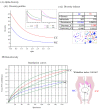Cultivable Microbiome Approach Applied to Cervical Cancer Exploration
- PMID: 38254804
- PMCID: PMC10813707
- DOI: 10.3390/cancers16020314
Cultivable Microbiome Approach Applied to Cervical Cancer Exploration
Abstract
Traditional microbiological methodology is valuable and essential for microbiota composition description and microbe role assignations at different anatomical sites, including cervical and vaginal tissues; that, combined with molecular biology strategies and modern identification approaches, could give a better perspective of the microbiome under different circumstances. This pilot work aimed to describe the differences in microbiota composition in non-cancer women and women with cervical cancer through a culturomics approach combining culture techniques with Vitek mass spectrometry and 16S rDNA sequencing. To determine the possible differences, diverse statistical, diversity, and multivariate analyses were applied; the results indicated a different microbiota composition between non-cancer women and cervical cancer patients. The Firmicutes phylum dominated the non-cancer (NC) group, whereas the cervical cancer (CC) group was characterized by the predominance of Firmicutes and Proteobacteria phyla; there was a depletion of lactic acid bacteria, an increase in the diversity of anaerobes, and opportunistic and non-typical human microbiota isolates were present. In this context, we hypothesize and propose a model in which microbial composition and dynamics may be essential for maintaining the balance in the cervical microenvironment or can be pro-oncogenesis microenvironmental mediators in a process called Ying-Yang or have a protagonist/antagonist microbiota role.
Keywords: aerobic and anaerobic cultures; cervical cancer; cervical epithelium; culturomics; microbiology.
Conflict of interest statement
The authors declare no conflict of interest.
Figures





Similar articles
-
Characterization of the cervical bacterial community in dairy cows with metritis and during different physiological phases.Theriogenology. 2018 Mar 1;108:306-313. doi: 10.1016/j.theriogenology.2017.12.028. Epub 2017 Dec 14. Theriogenology. 2018. PMID: 29284157
-
Preliminary Identification of the Aerobic Cervicovaginal Microbiota in Mexican Women With Cervical Cancer as the First Step Towards Metagenomic Studies.Front Cell Infect Microbiol. 2022 Feb 2;12:838491. doi: 10.3389/fcimb.2022.838491. eCollection 2022. Front Cell Infect Microbiol. 2022. PMID: 35186803 Free PMC article.
-
Characterization of Lung and Oral Microbiomes in Lung Cancer Patients Using Culturomics and 16S rRNA Gene Sequencing.Microbiol Spectr. 2023 Jun 15;11(3):e0031423. doi: 10.1128/spectrum.00314-23. Epub 2023 Apr 24. Microbiol Spectr. 2023. PMID: 37092999 Free PMC article.
-
Vaginal microbiome.Ceska Gynekol. 2018 Winter;83(5):371-379. Ceska Gynekol. 2018. PMID: 30848142 Review. English.
-
Disturbances of Vaginal Microbiome Composition in Human Papillomavirus Infection and Cervical Carcinogenesis: A Qualitative Systematic Review.Front Oncol. 2022 Jul 12;12:941741. doi: 10.3389/fonc.2022.941741. eCollection 2022. Front Oncol. 2022. PMID: 35903684 Free PMC article.
Cited by
-
Diagnostic and prognostic potential of the intra-tumoral microbiota profile in HPV-independent endocervical adenocarcinoma.Front Cell Infect Microbiol. 2024 Aug 16;14:1440017. doi: 10.3389/fcimb.2024.1440017. eCollection 2024. Front Cell Infect Microbiol. 2024. PMID: 39220287 Free PMC article.
-
The Urogenital System Microbiota: Is It a New Gamechanger in Urogenital Cancers?Microorganisms. 2025 Feb 1;13(2):315. doi: 10.3390/microorganisms13020315. Microorganisms. 2025. PMID: 40005682 Free PMC article. Review.
-
Transcriptomic analysis reveals Streptococcus agalactiae activation of oncogenic pathways in cervical adenocarcinoma.Oncol Lett. 2024 Oct 3;28(6):588. doi: 10.3892/ol.2024.14720. eCollection 2024 Dec. Oncol Lett. 2024. PMID: 39411203 Free PMC article.
-
In silico exploration of novel EGFR-targeting compounds: integrative molecular modeling, docking, pharmacokinetics, and MD simulations for advancing anti-cervical cancer therapeutics.Sci Rep. 2025 Mar 1;15(1):7334. doi: 10.1038/s41598-025-91135-4. Sci Rep. 2025. PMID: 40025089 Free PMC article.
-
Integrated analysis of microbiome and metabolome reveals insights into cervical neoplasia aggravation in a Chinese cohort.Front Cell Infect Microbiol. 2025 May 8;15:1556153. doi: 10.3389/fcimb.2025.1556153. eCollection 2025. Front Cell Infect Microbiol. 2025. PMID: 40406520 Free PMC article.
References
-
- Mitra A., MacIntyre D.A., Lee Y.S., Smith A., Marchesi J.R., Lehne B., Bhatia R., Lyons D., Paraskevaidis E., Li J.V., et al. Cervical intraepithelial neoplasia disease progression is associated with increased vaginal microbiome diversity. Sci. Rep. 2015;5:16865. doi: 10.1038/srep16865. - DOI - PMC - PubMed
Grants and funding
LinkOut - more resources
Full Text Sources
Molecular Biology Databases

